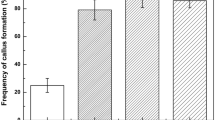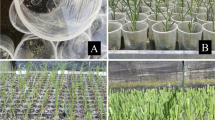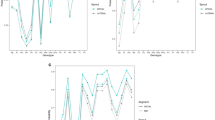Abstract
When tomato (Lycopersicon esculentum Mill.) callus or cell cultures were placed on media containing ribose as the sole carbon source, the tissues turned dark brown and ceased growth. However, after approximately 60 days bright green tissue able to grow on ribose emerged from 3 % of the brown necrotic callus tissue pieces plated. The selected tissue was highly organized, consisting of leafy primordia and associated meristematic tissues, sustained growth on ribose, and demonstrated the capacity to regenerate whole plants for at least 3 years. Cultures able to grow on ribose could not be selected from liquid suspension cultured tomato cells or from callus which had been mechanically macerated into cell aggregates containing less than approximately 100 cells. Plants regenerated from ribose adapted cultures were abnormal, having shortened internodes and thicker greener leaves. Regenerated plants were both male and female sterile.
Similar content being viewed by others
Abbreviations
- BAP:
-
N6-benzylaminopurine
- CFM:
-
callusforming medium
- IAA:
-
indole acetic acid
- SDM:
-
shoot determination medium
- RCM:
-
ribose containing medium
References
Caboche M (1987) Plant Cell Tiss.& Org.Cult. 8:197–206
Callebaut A, Motte JC, de Cat W (1987) J.Plant Physiol. 127:271–280
Chaleff RS, Parsons MF (1978) Genetics 89:723–728
Chong C, Taper CD (1972) Can. J. Bot. 50:1399–1404
Coffin R, Taper CD, Chong C (1976) Can.J.Bot. 54:547–551
Davis BD (1983) Am.J.Bot. 70:816–820
Gould AR (1986) In: Vasil IK (ed) Cell Culture and Somatic Cell Genetics of Plants. 3. Plant Regeneration and Genetic Variability, Academic Press, Inc., New York, pp 549–569
Gross KC, Pharr DM, Locy RD (1981) Plant Sci.Lett. 20:333–341
Handley LW, Locy RD (1983) Plant Cell Tiss.& Org.Cult. 3:237–243
Kapitsa OS, Kulinich AV, Vinetskii YP (1978) Genetika 14:2156–2168
Kinnersley AM, Henderson WE (1988) Plant Cell Tiss.& Org.Cult 15:3–16
Kochba J, Spiegel-Roy P, Saad S, Neuman H (1978) Naturwiss. 65:261–266
Lapena L, Perez-Bermudez P, Segura J (1988) Plant Sci. 57:247–252
Leva AR, Bertocci F (1988) Acta Horticul. 227:447–449
Levi A, Sink KC (1990) J.Plant Physiol. 137:184–189
Limberg M, Cress D, Lark KG (1979) Plant Physiol. 63:718–721
Loescher WH, McCamant T (1990) HortSci. 25:274–81
Maliga P (1980) In: Vasil IK (ed) Perspectives in Plant Cell and Tissue Culture; International Review of Cytology, Suppl 11 A, Academic Press, Inc., New York, pp 225–250
Maliga P (1984) Ann.Rev.Plant Physiol. 35:519–542
Maretzki A, Thom M, Nickel LG (1974) In: Street HE (ed) Tissue Culture and Plant Science, Academic Press, Inc., London, pp 329–361
Mathes MC, Morselli M, Marvin JW (1973) Plant & Cell Physiol. 14:797–801
Murashige T, Skoog F (1962) Physiol.Plant. 15:473–497
Nash DT, Boll WG (1975) Can.J.Bot. 53:179–185
Nickel LG, Maretzki A (1970) Plant & Cell Physiol. 11:183–185
Pieniazek J, Holobowicz T, Machnik B, Kaspzyk M (1978) Acta Horticul. 81:91–95
Street HE (1977) In: Street HE (ed) Plant Tissue and Cell Culture, 2nd Ed, University of California Press, Berkley, pp 61–102
Strickland SG, Nichol JW, McCall CM, Stuart DA (1987) Plant Sci. 48:113–121
Swedlund B, Locy RD (1994) Plant Physiol. 103:1339–1346
Thompson MR, Douglas TJ, Obata-Sasamoto H, Thorpe TA (1986) Physiol.Plant. 67:365–369
Verma DC, Dougall DK (1977) Plant Physiol. 59:81–85
Author information
Authors and Affiliations
Additional information
Communicated by I. K. Vasil
Rights and permissions
About this article
Cite this article
Locy, R.D. Selection of tomato tissue cultures able to grow on ribose as the sole carbon source. Plant Cell Reports 14, 777–780 (1995). https://doi.org/10.1007/BF00232921
Received:
Revised:
Issue Date:
DOI: https://doi.org/10.1007/BF00232921




